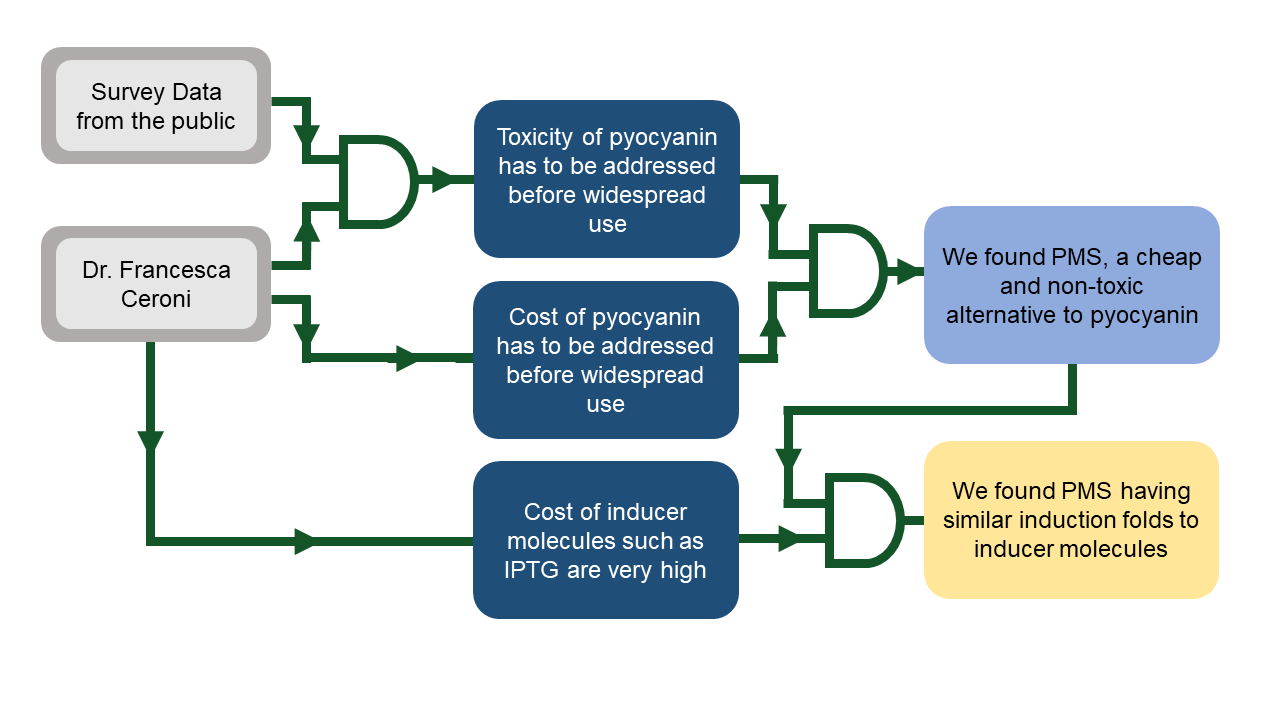| Line 22: | Line 22: | ||
<h3>Safety</h3> | <h3>Safety</h3> | ||
</br> | </br> | ||
| − | <p1> Our genetic circuit is activated/deactivated by the redox state of the transcription factor (SoxR). SoxR oxidation is modulated by small redox molecules, such as pyocyanin. However, after Dr. Francesca Ceroni, a PI at Imperial who was pregnant at the time declined to meet us in the lab out of concern of toxic substances as well as <a href="https://2018.igem.org/Team:Imperial_College/Public_Engagement#opinion"><b>public concern</b></a> on the toxicity of our system, we realized that toxicity is a huge factor in downstream implementation of our system. Pyocyanin is a toxin synthesised by the pathogen Pseudomonas aeruginosa and is implicated in its virulence <a href="https://www.sciencedirect.com/science/article/pii/S0924857912002105?via%3Dihub" class="highlight" target="_blank">(Ho Sui et. al., 2012)</a> | + | <p1> Our genetic circuit is activated/deactivated by the redox state of the transcription factor (SoxR). SoxR oxidation is modulated by small redox molecules, such as pyocyanin. However, after Dr. Francesca Ceroni, a PI at Imperial who was pregnant at the time declined to meet us in the lab out of concern of toxic substances as well as <a href="https://2018.igem.org/Team:Imperial_College/Public_Engagement#opinion"><b>public concern</b></a> on the toxicity of our system, we realized that toxicity is a huge factor in downstream implementation of our system. Pyocyanin is a toxin synthesised by the pathogen Pseudomonas aeruginosa and is implicated in its virulence <a href="https://www.sciencedirect.com/science/article/pii/S0924857912002105?via%3Dihub" class="highlight" target="_blank">(Ho Sui et. al., 2012).</a> We also realized that using another cheaper redox molecule could not only make our system cheaper to use, but also replace inducer molecules such as IPTG due to their price. Using PMS which is a small redox molecule, we can activate a gene much like IPTG would with p<i>lac</i>. Not only is PMS far cheaper than both pyocyanin and IPTG, it is also non-toxic and makes our system more applicable for real world applications. |
</br></br> | </br></br> | ||
<div class="center"><img src="https://static.igem.org/mediawiki/2018/5/50/T--Imperial_College--IHP11.png"></div> | <div class="center"><img src="https://static.igem.org/mediawiki/2018/5/50/T--Imperial_College--IHP11.png"></div> | ||
Revision as of 02:59, 17 October 2018
Integrated HP

Summary of Integrated Human Practices
Safety

Toxicity comparison between Pyocyanin and PMS
The 2012 OSHA Hazard Communication Standard ranks hazard ratings with the use of categories, with Category 0 being the lowest risk and Category 4 being the highest. With regards to toxicity, pyocyanin is a Category 4 substance (Santa Cruz Biotechnology, 2010) and extreme care was taken during our wet lab to ensure our own safety and any contact with pyocyanin would warrant immediate medical attention, PMS on the other hand is a Category 0 substance (Santa Cruz Biotechnology, 2017) and thus is far easier and safer to handle.Cost comparison between PMS and common inducer molecules
A cursory look at the costs of PMS, pyocyanin and common inducer molecules (such as IPTG) already reveal stark differences in costs per gram. When accounting for working concentrations, this difference is further magnified, with PMS being 407 times cheaper than IPTG and 6600 times cheaper than pyocyanin. These costs are summarized in a table below, where costs per gram are obtained using the lowest price per gram on Sigma-Aldrich. However costs only matter if it can be shown that PMS can have a similar fold induction to common inducer molecules such as IPTG and experimental results for fold induction suggesting that is the case can be found below.| Inducer | Working Concentrations | Price per gram (£) | Mass per liter of media (mg) | Price per liter of media (pence) | CAS No. | Relative price to PMS (%) |
|---|---|---|---|---|---|---|
| PMS | 0.2 uM | 15.76 | 0.0613 | 0.0966 | 299-11-6 | n/a |
| Pyocyanin | 2.5 uM | 12,120 | 0.526 | 638 | 85-66-5 | 660,000 |
| IPTG | 40 uM (https://www.neb.com/protocols/1/01/01/protein-expression-using-bl21de3-c2527) | 41.2 | 9.53 | 39.3 | 367-93-1 | 40,700 |
| L-Arabinose | 6.66 M (https://microbialcellfactories.biomedcentral.com/articles/10.1186/1475-2859-9-14) | 0.785 | 1000 | 78.5 | 5328-37-0 | 81,300 |
| aTc | 0.214 uM (https://openwetware.org/wiki/ATc) | 1650 | 0.0991 | 16.4 | 13803-65-1 | 17,000 |

Environment
Biocontainment


Fabric Bioprinter
Placeholder for Fabric Bioprinter GIF
Wellbeing














